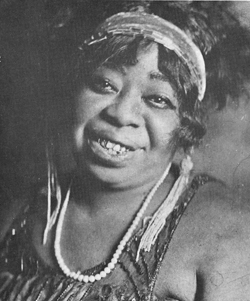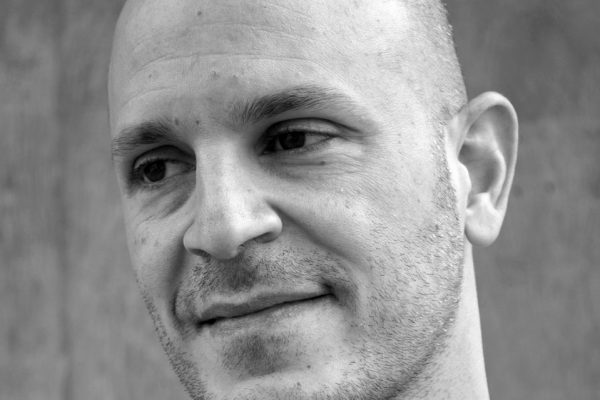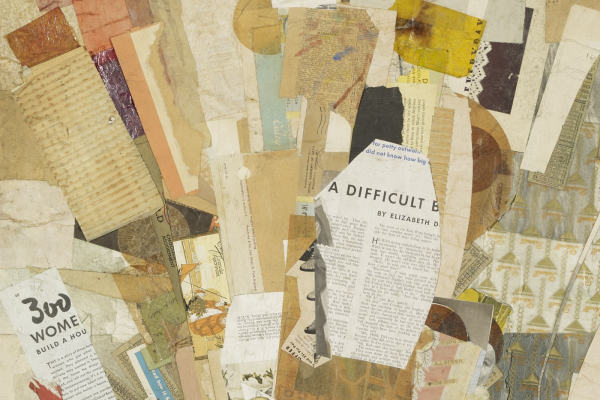-
 Once upon a time, a poet named Sterling Brown wrote a poem called “Ma Rainey.”
Once upon a time, a poet named Sterling Brown wrote a poem called “Ma Rainey.” - I love teaching “Ma Rainey”—usually in my Black Poetry survey course—because it opens so many doors for learning, all at once, and almost always gains a vastly under-recognized poet some well-deserved new fans. In it, Brown gives us a brief cultural history of a blues icon, a powerful exploration of voice and language in African American writing, and a brilliant literary performance of the relationship between a musical form and a poetic form. His genius emerges in the tour-de-force integration of the poem’s structure with its subject and theme. Langston Hughes first brought the blues into poetry, but Brown, in a single poem, stages for us the process by which that adaptation might have unfolded and reminds us why both Hughes and he—and numbers of poets to this day—work to recreate this black “folk” tradition within African American literature.
- The poem was about a performer named Gertrude Malissa Nix Pridgett, who became—after marriage, on the stage—“Ma Rainey.” She was a blues singer.
- I provide my students with some biographical info on Rainey, then before we do anything else, we listen to a recording of “Backwater Blues”—typically, Bessie Smith’s rendition, which is the most well-known and is easily accessible. (Students possessed of enough interest and time will have discovered it on YouTube before class.) At this point in the twenty-first century, few students—even those whose families have been in the United States for more than two generations—raise their hands when I ask if they’ve heard the blues before. Indeed, teaching as I do in New Jersey, most of my students of color (and a significant number of my students, regardless of race) are immigrants, or the children and grandchildren of immigrants, so the blues are not necessarily integral to their cultural frame of reference. We sit in the cradle of Smith’s muscular croon and listen to her mournful song.
- She was a beloved blues singer, with a massive following, particularly among African American Southerners. As a native of Georgia, she spoke their language.
- We then turn to the poem—which is composed of four visually distinct, numbered parts—and read it through aloud. When I ask them to think about how Brown’s diction and lexicon reinforce the poem’s major themes, they are quick to identify the language referring to water, most obviously the “delta,” the “little river settlements,” and, along with the invocation of “Backwater Blues” itself, the “storm,” the “rain,” and the implied flood appearing in its lyrics. Someone will point to how Brown uses water imagery to give us a sonic impression of Ma Rainey’s audiences: “Cheerin’ lak roarin’ water, lak wind in river swamps.” If I urge them to continue, the geographically minded students will recognize that the place-names Brown includes in Part I are all towns and cities located along the Mississippi River. The verbally inclined will point out that the pianist “ripples” his instrument’s keys and help the rest of the class see and hear the fluid river of admiring fans in Brown’s neologism “flivverin’.” If no one else mentions it, I call attention to the tears shed in the penultimate stanza. Water, water, everywhere . . .
- She was a commercially successful blues singer, who cut around a hundred recordings for Paramount and performed with such musicians as Thomas Dorsey and Louis Armstrong.
- My students are now prepared to understand Brown as a poet for whom every word counts. I give them three threads to track: (1) line, (2) address, and (3) rhyme, promising that Brown’s attention to detail will make our attention to these threads pay off. We go back to the beginning and take a look at Part I. Here Brown’s uniformly short lines, structured around a two-beat accentual meter, flow down the page. This rapid vertical movement suggests how Rainey’s touring circuit might have snaked along the Mississippi toward the Gulf of Mexico or the way her fans would have streamed into town to catch her show. The speed with which we proceed through the lines conveys something of the excitement generated by Rainey’s approach. The speaker seems to have a bird’s-eye view of these events, speaking from a distance almost impersonal—in the absence of first- and second-person pronouns—but for the way his black vernacular diction identifies him with Rainey’s devoted fan base. The rhyme scheme in this section complements the sonic and visual emphasis on movement: the abcb pattern of rhyme propels us through a series of quatrains—undemarcated, as if not to slow us down—the last of which Brown turns into a sestet by tripling the rhyme (“down,” “town,” “aroun’”).
- She had a band and a bus, and toured widely through the 1920s and into the ’30s, drawing large crowds everywhere she went. She was famous not only for the voice captured on vinyl, but also for her intensely charismatic stage presence.
- When we turn to Part II, my students readily note the striking visual difference in the lines. If the poem flowed vertically in Part I, in Part II it pools out horizontally. The poem overflows its structural banks, we might say, slowing the pace and visually foreshadowing the floods that “Backwater Blues” will invoke in Part IV. The speaker retains a third-person perspective but collapses the distance we identified in Part I as he takes us in for a closer look at the people who love her music. I urge students to notice that the people are carefully characterized as laborers, coming from “cornrows and from lumber camps,” their lives organized around work that is seasonal, low-paying, and, in those days, certainly exploitative. Brown again hints at the “trouble” flooding brings to Rainey’s audiences, so vulnerable to displacement and homelessness, through the very language he uses to describe them: the noise they make, though joyful, is ominously likened to the sounds of a storm. The stanza break between the now-visible quatrains contributes to our sense that the poem slows down, as does even the rhyme scheme’s shift from abcb to abab. The doubly recursive rhyme in that second quatrain mirrors the doubling of joy and pain that the blues has always captured. Thus the “jokers” with “deir laughs” are shadowed in the next line by the “folks” with “deir aches an’ miseries,” while Rainey’s “gold-toofed smiles” find their balance in the subsequent line’s reference to Long Boy’s “minors,” the defining tone of the blues. I always find some students familiar with the concept, so relevant here, of “laughing to keep from crying.”
- When the Great Depression and the waning popularity of blues undermined her performance circuit, she returned to Georgia and bought two theaters with the money she had earned and saved.
- Part III is the shortest section, but it is also the pivot for the narrative Brown is telling (by performing it) about how and why poets want the blues for poetry. Here I explain to my students that—according to Blues People (1963), the rich history of African American music by LeRoi Jones (later Amiri Baraka)—the earliest blues used the rhyming quatrains we associate with the English ballad tradition. Over time the form morphed into the three-line AAB structure that typifies the blues in popular culture, where the first line is repeated, more or less verbatim, before the rhyme is completed in line three. In “Ma Rainey,” Brown enacts a step in this transition from rhyming pairs and quatrains to triple rhymes and tercets. At first glance, Part III might seem to turn back to the abcb-rhymed quatrains found in Part I. Students note quickly, however, that it is instead only the final triplet that has been carried over; Part III is composed not of three quatrains, but of two sestets. More striking is what happens with address. My students eagerly point out that the speaker has taken on a first-person plural voice, has become a part of the people he was describing in Part II, who now speak directly to the performer (“O Ma Rainey, / Sing yo’ song”). They address her familiarly (“O Ma Rainey, / Li’l an’ low”) and claim her for themselves (“Now you’s back / Whah you belong”). We learn from their own mouths, so to speak, why they come from “miles aroun’” to “hear / Ma do her stuff”: because “her stuff” is not simply entertainment: it gives voice to the “hard” and “lonesome” realities of their lives and reflects how resilient they are and “mus’” be in the face of natural disasters and unnatural dispossessions. Her music—metonymic for the blues, generally—is nurturing, sustaining, “keep[s] us strong.”
- She managed her theaters until her death of heart disease at the untimely age of fifty-three.
- By the time we reach Part IV, my students are ready to absorb what Brown’s meticulous crafting has accomplished. They are instantly attuned to the speaker’s switch to the first-person singular. Further, they are conscious of the multiple “frames” through which the speech in this part of the poem is presented: Brown gives us the words of a speaker, who introduces the words of “a fellow” he has talked to, who in turn rehearses three stanzas of “Backwater Blues” as he apparently once heard Ma Rainey perform it. Her song is embedded in the deepest layer of these frames, as if to realize the request her audience makes in Part III, entreating her to “git way inside us.” Brown represents Rainey’s singing with strikingly redundant typographical markers, indenting it, placing it within quotation marks, and setting it in italics. My students are adept at identifying these elements of the poem, which function as visual indicators of readers’ distance from Rainey’s vocal performance.
- As a mesmerizing performer, powerful vocal artist, and the first woman to have a career as a professional blues singer, she was rightly called “The Mother of the Blues.”
- My students often overlook another important signal of this distance, however, even when I ask them point-blank: How are these stanzas in the poem different from the song as we heard it earlier? Sooner or later, a student will point out that the poem reproduces the lyrics as two-line stanzas rather than the three-line stanzas we heard sung. Indeed, Brown doesn’t represent the second line of the stanzas, because—being more or less identical to the lines they follow—their repetition is made meaningful primarily through the way the singer “worries the line” (i.e., varies the notes, emphasis, pitch, and pacing of the line, vocally). Poetry cannot convey that sonic difference, Brown seems to concede.
- While she did many things—performing in vaudeville minstrel shows early in her career, for one, and singing about and acting upon bisexual desire, for another—one thing she didn’t do was popularize or even record the song “Backwater Blues.” Perhaps Brown chose to feature it in his poem about Ma Rainey, because, in the end, he just couldn’t resist the pun.
- Sterling Brown knew that poets had to use different methods in creating the necessary variation upon repeated lines. He shows us how it’s done in the stanza following the lyrics to “Backwater Blues.” I point out that this stanza returns to the horizontal shape first seen in Part II, while holding onto the tripled rhyme of Part III, thus integrating some of the poem’s competing visual and sonic impulses. We discuss the way he takes the latter half of the first line (“bowed dey heads an’ cried”) and opens it up for elaboration in the second line (“Bowed dey heavy heads, shet dey moufs up tight an’ cried”), a verbal “worrying” as expressive in its own way as the vocal variety can be. I wonder aloud whether this is one reason Brown has chosen to depict her singing a blues she didn’t record—to prevent us from comparing the poem about her performance to the performance itself. Maybe Rainey’s appeal must remain ineffable, as suggested by the words of “the fellow” who can only say: “‘She jes’ catch hold of us, somekindaway.’” But the poem calls this interpretation into question. The third line of Brown’s blues stanza reminds us of what may be just as important as her commanding presence and the raw power of her voice. When Rainey’s song strikes a particularly painful chord with her audience, she feels it, too, and doesn’t hold herself apart (“Ma lef’ de stage, an’ followed some de folks outside”). The speaker is clear: it is precisely “dataway” that she “gits hold of” people, particularly the “folk”: by articulating their feelings and identifying with them. I leave my students with the proposition that Brown’s inclusion of black vernacular speech and blues form in his poetry reflects his desire to get hold of his own audiences and offer us aspects of African American culture that—like Ma Rainey’s performances—will continue, through an ongoing struggle for freedom, to keep us strong.
Read more Teacher Features: Poet-teachers on Teaching Poetry








